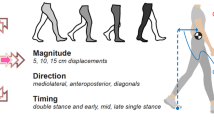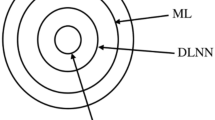Abstract
In order to use humanoid robots in our daily lives, stable robot walking is very important. This paper proposes a posture balance controller for a humanoid robot in order to achieve stable locomotion. The robot was modeled in simplified form as an inverted pendulum having a spring and a damper and the state feedback controller based on a disturbance and a state observer estimating the angle and angular velocity of the center of mass (COM) was developed with the simple model. Since a humanoid robot has different modeling parameters according to a number of the supporting legs and/or moving direction, four controllers were designed. With considering disturbance, the robot could estimated the state exactly and maintained the posture balance while disturbance is applied to the robot. The proposed controller was applied to a humanoid robot, DRC-HUBO2, and it was verified with some experiments in the lab and success of the stair mission in the DRC Finals 2015.
Similar content being viewed by others
References
Carpentier, J., Benallegue, M., Mansard, N., Laumond, J.P.: Center-of-mass estimation for a polyarticulated system in contact – a spectral approach. IEEE Trans. Robot. 32(4), 810–822 (2016)
Cho, B.K., Kim, J.H., Oh, J.H.: Online balance controllers for a hopping and running humanoid robot. Adv. Robot. 25, 1209–1225 (2011)
Cho, B.K., Park, I.W., Oh, J.H.: Running Pattern Generation of Humanoid Biped with a Fixed Point and its Realization. Int. J. Humanoid Robot. 06(04), 631–656 (2011)
Fallon, M.F., Antone, M., Roy, N., Teller, S.: Drift-Free Humanoid State Estimation Fusing Kinematic, Inertial and Lidar Sensing. In: 2014 IEEE-RAS International Conference on Humanoid Robots, pp. 112–119 (2014)
Jun, Y., Jang, G., Cho, B.K., Trubatch, J., Kim, I., Seo, S.D., Oh, P.Y.: A Humanoid Doing an Artistic Work - Graffiti on the Wall. In: 2016 IEEE/RSJ International Conference on Intelligent Robots and Systems (IROS), pp. 1538–1543. https://doi.org/10.1109/IROS.2016.7759249 (2016)
Kajita, S., Kanehiro, F., Kaneko, K., Fujiwara, K., Harada, K., Yokoi, K., Hirukawa, H.: Biped Walking Pattern Generation by Using Preview Control of Zero-Moment Point. In: 2003 IEEE International Conference on Robotics and Automation (Cat. No.03CH37422), vol. 2, pp. 1620–1626. https://doi.org/10.1109/ROBOT.2003.1241826 (2003)
Kajita, S., Kanehiro, F., Kaneko, K., Fujiwara, K., Harada, K., Yokoi, K., Hirukawa, H.: Resolved Momentum Control: Humanoid Motion Planning Based on the Linear and Angular Momentum. In: 2003. (IROS 2003). Proceedings. 2003 IEEE/RSJ International Conference On Intelligent Robots and Systems, pp. 1644–1650. IEEE (2003)
Kajita, S., Yamaura, T., Kobayashi, A.: Dynamic walking control of a biped robot along a potential energy conserving orbit. IEEE Trans. Robot. Autom. 8(4), 431–438 (1992). https://doi.org/10.1109/70.149940
Kaneko, K., Kanehiro, F., Morisawa, M., Akachi, K., Miyamori, G., Hayashi, A., Kanehira, N.: Humanoid Robot HRP-4 - Humanoid Robotics Platform with Lightweight and Slim Body. In: IEEE/RSJ International Conference on Intelligent Robots and Systems (IROS), pp. 4400–4407. IEEE (2011)
Khatib, O., Sentis, L., Park, J.H.: A Unified Framework for Whole-Body Humanoid Robot Control with Multiple Constraints and Contacts. In: European Robotics Symposium, pp 303–312. Springer, Berlin (2008)
Komura, T., Nagano, A., Leung, H., Shinagawa, Y.: Simulating pathological gait using the enhanced linear inverted pendulum model. IEEE Trans. Biomed. Eng. 52(9), 1502–1513 (2005)
Lee, S., Kim, J.Y., Kim, M.: Development and walking control of emotional humanoid robot, KIBO International Journal of Humanoid Robotics (2013)
Nagasaki, T., Kajita, S., Kaneko, K., Yokoi, K., Tanie, K.: A running experiment of humanoid biped. In: 2004. (IROS 2004). Proceedings. 2004 IEEE/RSJ International Conference on Intelligent Robots and Systems, pp. 136–141. IEEE (2004)
Paul, O., Kiwon, S., Giho, J., Youngbum, J., Baek-Kyu, C.: Technical overview of team drc-hubo@unlv’s approach to the 2015 darpa robotics challenge finals. J. Field Robot. 34(5), 874–896 (2017)
Pratt, J., Carff, J., Drakunov, S., Goswami, A.: Capture Point: A Step Toward Humanoid Push Recovery. In: 2006 6Th IEEE-RAS International Conference on Humanoid Robots, pp. 200–207 (2006)
Rotella, N., Bloesch, M., Righetti, L., Schaal, S.: State Estimation for a Humanoid Robot. In: 2014 IEEE/RSJ International Conference on Intelligent Robots and Systems, pp. 952–958. https://doi.org/10.1109/IROS.2014.6942674 (2014)
Rotella, N., Herzog, A., Schaal, S., Righetti, L.: Humanoid Momentum Estimation Using Sensed Contact Wrenches. In: 2015 IEEE-RAS 15Th International Conference on Humanoid Robots (Humanoids), pp. 556–563. https://doi.org/10.1109/HUMANOIDS.2015.7363417 (2015)
Rotella, N., Mason, S., Schaal, S., Righetti, L.: Inertial Sensor-Based Humanoid Joint State Estimation. In: 2016 IEEE International Conference on Robotics and Automation (ICRA), pp. 1825–1831 (2016)
Stephens, B.: Integral Control of Humanoid Balance. In: 2007. IROS 2007. IEEE/RSJ International Conference on Intelligent Robots and Systems, pp. 4020–4027 (2007)
Stephens, B.J.: State estimation for force-controlled humanoid balance using simple models in the presence of modeling error. Robotics and Automation (ICRA) (2011)
Takenaka, T., Matsumoto, T., Yoshiike, T.: Real Time Motion Generation and Control for Biped Robot -1St Report: Walking Gait Pattern Generation-. In: IEEE/RSJ International Conference on Intelligent Robots and Systems (IROS), pp 1084–1091. IEEE, St. Louis (2009)
Takenaka, T., Matsumoto, T., Yoshiike, T., Hasegawa, T., Shirokura, S., Kaneko, H., Orita, A.: Real Time Motion Generation and Control for Biped Robot -4Th Report: Integrated Balance Control-. In: IEEE/RSJ International Conference on Intelligent Robots and Systems (IROS), pp. 1601–1608. IEEE (2009)
Takenaka, T., Matsumoto, T., Yoshiike, T., Shirokura, S.: Real Time Motion Generation and Control for Biped Robot -2Nd Report: Running Gait Pattern Generation-. In: IEEE/RSJ International Conference on Intelligent Robots and Systems (IROS), pp. 1092–1099. IEEE (2009)
Vukobratovic, M., Borovac, B.: Zero-Moment Point – Thirty Five Years of Its Life. Int. J. Humanoid Robot. 01(01), 157–173 (2004)
Xinjilefu, X., Feng, S., Atkeson, C.G.: Center of Mass Estimator for Humanoids and Its Application in Modelling Error Compensation, Fall Detection and Prevention. In: 2015 IEEE-RAS 15Th International Conference on Humanoid Robots (Humanoids), pp. 67–73 (2015)
Acknowledgments
This work was supported by the Technology Innovation Program (10070171, Development of core technology for advanced locomotion/manipulation based on high-speed/power robot platform and robot intelligence) funded By the Ministry of Trade, Industry & Energy (MOTIE, Korea).
Author information
Authors and Affiliations
Corresponding author
Additional information
Publisher’s Note
Springer Nature remains neutral with regard to jurisdictional claims in published maps and institutional affiliations.
Appendix A: Controllers for experiment
Appendix A: Controllers for experiment
1.1 A.1 Controller for DSP in the Sagittal Plane
The state space equation is as below:
The observer gain and the controller gain are given below:
The control law is as below:
where k is 4658 Nm/rad.
1.2 A.2 Controller for DSP in the Frontal Plane
The state space equation is as below:
The observer gain and the controller gain are given below:
The control law is as below:
where k is 6672 Nm/rad.
1.3 A.3 Controller for SSP in the Sagittal Plane
The state space equation is as below:
The observer gain and the controller gain are given below:
The control law is as below:
where k is 2698 Nm/rad.
1.4 A.4 Controller for SSP in the Frontal Plane
The state space equation is as below:
The observer gain and the controller gain are given below:
The control law is as below:
where k is 1694 Nm/rad.
Rights and permissions
About this article
Cite this article
Cho, BK., Ahn, D., Jun, Y. et al. A Posture Balance Controller for a Humanoid Robot using State and Disturbance-Observer-Based State Feedback. J Intell Robot Syst 95, 331–349 (2019). https://doi.org/10.1007/s10846-018-0928-z
Received:
Accepted:
Published:
Issue Date:
DOI: https://doi.org/10.1007/s10846-018-0928-z




